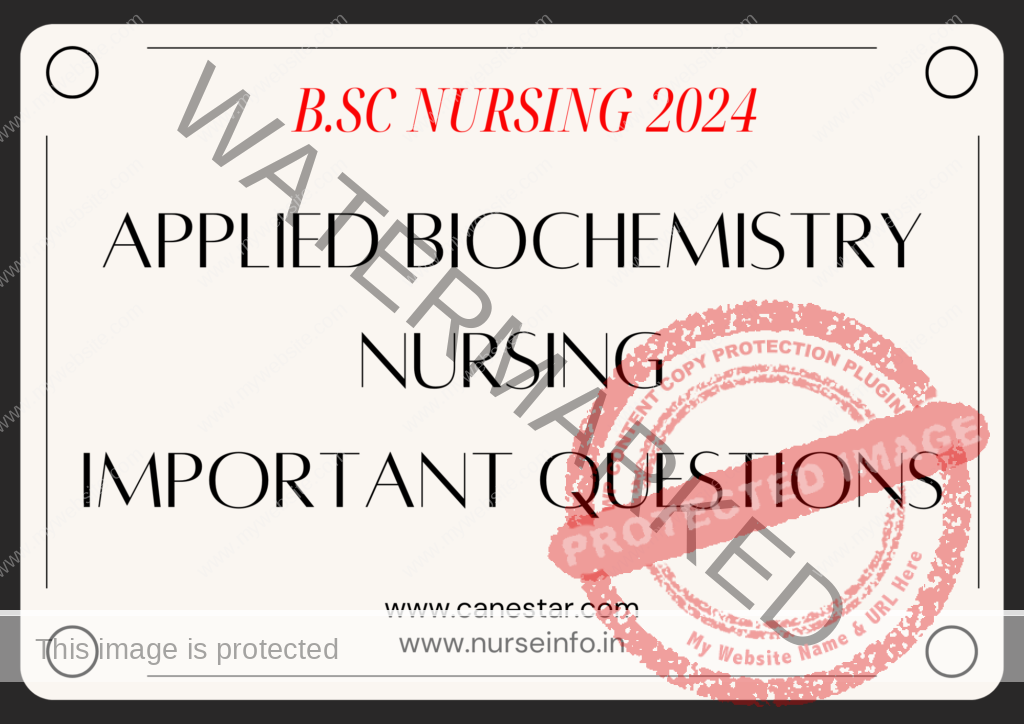APPLIED BIOCHEMISTRY
IMPORTANT QUESTIONS
FOR BSC NURSING 2024
Unit : 1
Structure and functions of cell
Structure of mitochondria
Microscopy
Unit : 2
Prokaryotes and eukaryotes
Fluid mosaic model of cell membrane
Transport mechanism
Acid base balance
Sodium pump
Unit : 3
Classification of carbohydrate
Function of carbohydrate
Glycolysis
Krebs cycle
Pentose phosphate pathway
Cori cycle
Unit : 4
Classification of lipids
Functions of lipids
Steroids
Cholesterol metabolism
Beta oxidation of fatty acid
Lipoproteins
Unit : 5
Nitrogen metabolism
Classification of enzymes
Urea cycle
Enzyme kinetics
Properties of enzymes
Bile pigments
Ketone bodies
Unit : 6
Fat soluble and water soluble vitamins
Vitamin Deficiency
Unit : 7
Immune response
Structure and classification of immunoglobulins
Mechanism of antibody production
HLA antigen
Free radicals and antioxidants
Specialized proteins
ELISA
Electrophoresis
Chromatography.
10 Mark
1. aerobic glycolysis. Energistics and pathway (important)
2. Beta oxidation of fatty acid. Palmitic acid oxidation (important)
3. Composition of cell. Structure and function of cell membrane (diagram) (important)
4. TCA cycle and energistics (imporant)
5. Sources, deficiency and RDA and function of Vitamin D
6. Citric acid Cycle and energistics
7. Acid base balance (important)
8. Vitamin C – sources, requirement, deficiency (important)
9. Metabolism of tyrosine
10. Serum calcium level – sources, daily requirement and biochemical
11. Classification of enzymes (important)
12. Ketone bodies and ketosis (important)
13. Vitamin A
14. Gluconeogenesis
15. Enzyme inhibition
16. HMP pathway (important)
17. Urea cycle (important)
18. Digestion and absorption of proteins
5 Mark
1. urea Cycle (important)
2. Formation and utilization of ketone bodies (important)
3. Renal regulation of acid base balance (important)
4. Classify carbohydrate
5. Steps in beta oxidation palmityl CoA
6. Functional classification of protein
7. Triacyl glycerol synthesis (TAG)
8. Different types of lipoprotein and its function (important)
9. Factors influencing enzyme activity (important)
10. Classify enzymes with examples (important)
11. Absorption,transport and storage of iron
12. Biochemical functions of Vitamin A
13. Homopolysaccharides
14. Blood buffers
15. Phospholipids
16. Creatinine clearence test
17. Deficiency of Vitamin A
18. Urea cycle (important)
19. Functions of plasma proteins (important)
20. Serum enzymes
21. HMP pathway (important)
22. BMR (important)
23. Glucose tolerance test
24. Isoenzymes and significance
25. Function of vitamin C
26. Types of immunoglobulins (important)
Short Answers
1. anti-oxidants
2. Biochemical function of calcium
3. Competitive inhibition of enzymes
4. Functions of ascorbic acid
5. Normal range – Random blood glucose, serum cholesterol, serum bilirubin
6. Deamination
7. Essential fatty acids
8. Function of thiamine
9. Three enzymes of diagnostic importance
10. Normal serum level – sodium, potassium and calcium
11. Starch
12. Heat coagulation test
13. Hyperglycemia
14. Essential aminoacids
15. Bile salts and its function
16. Hypercholesteromia
17. Mitochondria
18. Rothera test
19. Ketone bodies
20. Metabolic acidosis
21. HMP Shunt pathway
22. Immunoglobulin G
23. Pellagra
24. Denaturation of proteins
25. Beri Beri
26. Benedict’s test
27. Normal level of blood urea and fasting blood sugar
28. Transmination
29. Metabolic alkalosis
30. Iodine
31. Biological important compound from cholesterol
32. Normal level – FBS, blood urea, Serum total protein and SGOT
33. Two proteolytic enzymes
34. Coenzyme form of thiamine and pyridoxine
35. Normal blood levels of cholesterol and urea
36. Lactose intolerance
37. Dietary fibre
38. Daily requirement of vit A and D
39. Primary structure of proteins
40. Active transport
41. Glycosuria
42. Function of mitochondria
43. Rickets
44. Examples for pro vitamin
45. Marker enzymes in myocardial infarction
46. Golgi apparatus
47. Electrophoresis
48. Sodium pump

